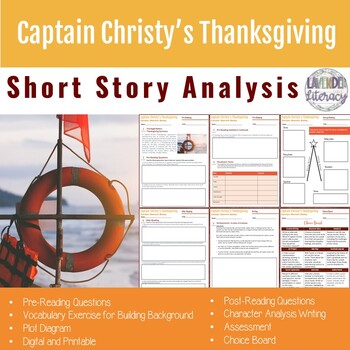Captain Christy's Thanksgiving | Short Story Analysis
- PDF
- Google Apps™

Description
Captain Christy's Thanksgiving | Short Story Analysis
Short Story Analysis: Middle School Short Stories
This short story analysis is perfect for accompanying the short story "Captain Christy's Thanksgiving" by Carolyn Sherwin Bailey. This comprehensive digital or printable resource will promote critical thinking while engaging students in text-dependent tasks.
Pre-reading activities support students' thinking by building background and vocabulary. During reading, students will complete a graphic organizer to support their thinking and identify key story elements, including exposition, rising action, climax, falling action, resolution, and theme. Next, students will answer 8 text-dependent questions that will assess reading comprehension while fostering reflection and critical thinking. Then, students will complete a writing analysis activity to deepen their understanding of the text while practicing important writing skills.
A 10-question multiple-choice assessment will evaluate students' comprehension of the story. Finally, students will select from 9 task board choices to demonstrate understanding through performance-based tasks. This is perfect for differentiation and addressing multiple learning styles. An answer key is included for ease of grading.
Please note that the text of the story is included with this resource, and it can also be easily found through a Google search.
What's Included in Your Purchase?
- PDF printable version
- Google Drive format for digital classrooms-uses Google Slides so students can type directly in the resource Building background questions.
- Google Drive link to PDF of the text
- Vocabulary analysis for building background before reading
- Story Map Graphic Organizer
- 8 post-reading, open-ended questions to assess comprehension
- 1 writing exercise
- 10 multiple choice assessment questions to evaluate students' understanding of the story
- Choice board with 9 tasks ranging from writing tasks to performance-based activities
- Answer Key
- Perfect for grades 5-6!
The link to the Google Drive copy is included on the first page of the downloaded resource. Once you download the resource, you can click the link. You will be prompted to make a copy. Once you do, it will be ready for student use.
Thank you so much for your purchase! I would love to hear your feedback! Please consider leaving a comment if you like what you see! Did you know that you will earn credits toward future purchases for every rating and comment you leave on TPT? That means free resources for you!
If you have questions about a resource, please feel free to email me at medillon925@gmail.com, and I will get back to you. I strive to make quality products to save you time, and I value your input.
Happy teaching!





